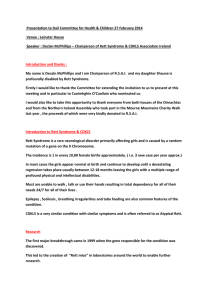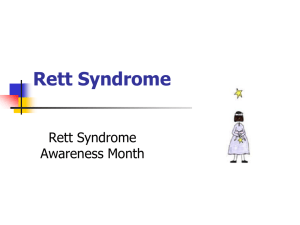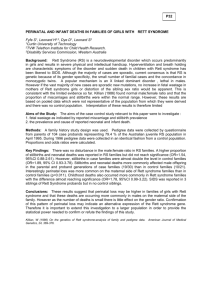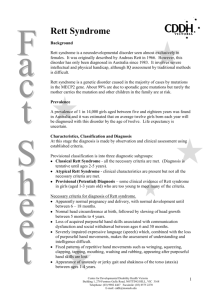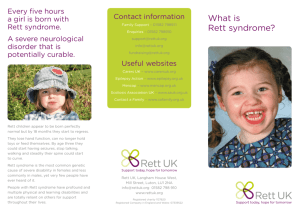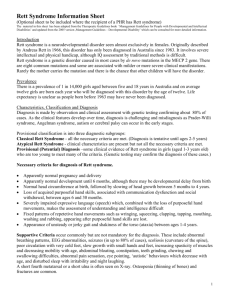Rhett's Disorder - School Based Behavioral Health
advertisement
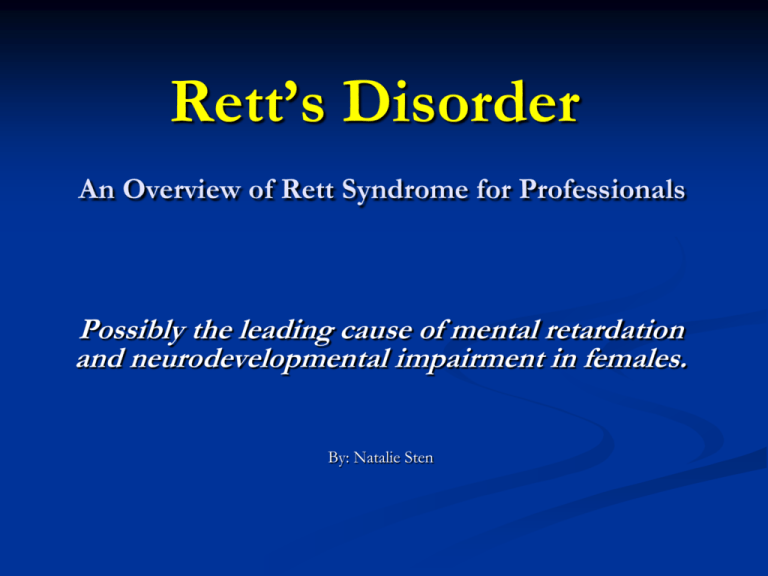
Rett’s Disorder An Overview of Rett Syndrome for Professionals Possibly the leading cause of mental retardation and neurodevelopmental impairment in females. By: Natalie Sten After this seminar you will be able to: List the warning signs and symptoms of Rett Syndrome. Describe how to cope with children with Rett Syndrome and what the most important aspects of treatment are. State how school dynamics can play a critical role in the development of children with Rett Syndrome. GLOSSARY Rett Syndrome (RS): A neurodevelopmental disorder that is classified as a pervasive developmental disorder Pervasive Development Disorders (PDD): Refers to a group of five disorders characterized by delays in the development of multiple basic functions including socialization and communication. Apraxia: A neurological disorder characterized by loss of the ability to execute or carry out learned purposeful movements, despite having the desire and the physical ability to perform the movements. Respite Care: The provision of short-term, temporary relief to those who are caring for family members who might otherwise require permanent placement in a facility outside the home. What is diagnostic criteria for Rett Syndrome? Diagnostic Criteria for 299.80 Rett's Disorder All of the following: apparently normal prenatal and perinatal development apparently normal psychomotor development through the first 5 months after birth normal head circumference at birth (www.cdc.gov/ncbddd/autism/overview_diagnostic_criteria.htm) Diagnostic Criteria Continued… Onset of all of the following after the period of normal development: deceleration of head growth between ages 5 and 48 months loss of previously acquired purposeful hand skills between 5 and 30 months with the subsequent development of stereotyped hand movements (e.g., hand-wringing or hand washing) loss of social engagement early in the course ( although often social interaction develops later) appearance of poorly coordinated gait or trunk movements severely impaired expressive and receptive language development with severe psychomotor retardation (www.cdc.gov/ncbddd/autism/overview_diagnostic_criteria.htm) RS is Associated with PDDs or Autistic Spectrum Disorder Autism, also called autistic disorder, is a complex developmental disability that appears in early childhood, usually before age 3. Autism prevents children and adolescents from interacting normally with other people and affects almost every aspect of their social and psychological development. How is Rett Syndrome Associated with Autism? Girls with RS often have autistic-like characteristics (speech & emotional contact impairment/ repetitive hand gestures) at an early age but differences begin to occur as the child continues to grow. The critical difference is the gene mutation that is defining of RS. However, females meeting criteria for RS do not meet the symptoms for autism. Symptoms seen in RS that are NOT seen in Autism are: Deceleration of the rate of head growth Loss of purposeful hand skills Mobility or the irregular breathing patterns Repertoire of purposeless hand stereotypes Children with RS almost always prefer people to objects Children with RS often enjoy affection Who is affected by RS? Rett Syndrome occurs from 1 in 15,000 female births. A girl is born with RS once every 5 hours around the world. More than 99.5 % of RS occur only once in a family. Until 2000, RS was thought to occur only in girls but a small number of cases have been reported in boys also. Warning Signs and Symptoms: There are 4 stages in the child’s development: Stage 1: Early Onset (6-18 months) Slowing of an infant’s head growth after 5 months, may not make eye contact, and may not show interest in toys. Could be calm, quiet, and use repetitive hand movements such as hand washing or clapping. Most girls crawl without using their hands. Stage 2: Rapid Destructive (1-4 yrs old) Severe impairments in speech and the lack of ability to perform motor functions, including chewing and swallowing. Repeated hand stereotypes become common along with possible abnormal sleeping patterns, teeth grinding, and loss of muscle tone. Evident incidents of breath holding or hyperventilating can occur. May become irritable because of communication barriers and walk unsteadily due to curvature of the spine. Warning Signs and Symptoms Continued… Stage 3: Plateau (2-10 yrs. old) Motor development is delayed (Apraxia), gastrointestinal disorders and seizures often appear. The child’s behavior frequently shows some improvement such as less irritability and crying, better communication skills, and an increase in attention span. Many patients diagnosed with RS stay in this stage for most of their lives. Stage 4: Late Motor Deterioration (Usually after age 10) Patients could slowly lose their mobility, including not walking at all. However, there is no loss of cognitive, hand or communication skills. Recurring hand gestures often decrease. Scoliosis may develop along with muscle inflexibility. Do biological factors play a role? Rett Syndrome: Is a neurodevelopmental disorder that is quite rare. It causes a genetic mutation, linked to the X chromosome, which affects the production of a vital protein that controls brain development. School dynamics associated with students with RS: A secure emotional environment is the first, most important aspect of a teaching environment so that children feel safe. Children with RS could be placed in a variety of classrooms from special education units to full inclusion according to their own individual needs and abilities. Structured, stimulating, restrictive-free classroom environments with direction and organization are necessary. Interventions must be created based on the individualized needs of the child! What can families do? Respite care is the number one answer to the question: What do families need the most? It is important to ask the caseworker if the family qualifies for any other state or federal programs. A caseworker may not volunteer information about additional funds and programs!! Stimulating environments at home: Provide early exposure to age-appropriate books, toys and music even if the child with RS appears uninterested. Be aware of other signals to identify RS! (Renee Succa story) Be patient. It may take longer for a child with RS to respond. Give the child plenty of time and space. Following directions may be challenging due to apraxia. Emotionally motivate your child by identifying his/her interests. Can you think of some emotionally motivating movements that could occur automatically? It’s the Law in Pennsylvania A child with RS is covered by the The Individuals with Disabilities Education Act (IDEA). This law was created to ensure services to children with disabilities throughout the nation. IDEA controls how states and public agencies provide early intervention, special education and related services to children with disabilities. Infants and toddlers with disabilities (birth-2) and their families receive early intervention services. Children and youth (ages 3-21) receive special education and related services. (www.elc-pa.org) PA Law Continued… Your school district is required to provide transportation to regular neighborhood schools, early childhood classroom and special needs classroom if your school district does not have all of these programs available (if an out–of–district program is the most appropriate for your child). By law, a special education evaluation is a right of every child. If an individualized education plan is determined to be needed, the IEP must be developed within 30 calendar days after eligibility for special education is determined. The IEP must be completed before actual placement and before the start of special education and related services. Unless requested more often, all IEPs must be reviewed at least annually by the IEP committee. (www.elc-pa.org) How you can help: Raise awareness by encouraging policy changes and funding by the scientific community and policy makers. HOW? Go to www.rettsyndrome.org to learn more on awareness and advocacy. Do not give up!! Parents and professionals can expect difficulties. What can help you cope? Talk about it. Be gentle with yourself. Learn how to ask for help. Trust your instincts. Learn to let go and to accept what can’t be changed. Let’s talk about Lily’s Journey. TREATMENT “Nutrition represents one of the most important aspects of treatment in RS. It is the cornerstone by which all other forms of therapies are made possible.” -Marylynne Rice Asaro, Registered Dietician Weight gain is poor in more than 85% of girls with RS. Early interventions will aid in providing necessary calorie intake and proper nutrition. High-fat, high-calorie diet; delivery of liquid nutrients directly to the stomach using a tube inserted through the nose (nasogastric feeding) or gastrostomy feeding. In addition, sufficient intake of fluids and high-fiber foods is important in alleviating constipation. (www.wemove.org/rett/rett_tre.html) Therapies Include: Aquatic Rehabilitation Hydrotherapy Love Therapy Music Therapy Physical Therapy Therapist's Role Behaviors Hippotherapy Motor Development Occupational Therapy Speech Therapy Where to go for more info? 1) International Rett Syndrome Association www.rettsyndrome.org 2) NIH/National Institute of Neurological Disorders and Stroke www.ninds.nih.gov 3) National Institute of Child Health and Human Development (NICHD) www.nichd.nih.gov References Affholder, C. (1998). Lily’s Journey. [Electronic Version]. IRSA Fall Newsletter. American Psychiatric Association. (2000). Diagnostic and Statistical Manual of Mental Disorders, Fourth Edition. Retrieved September 20, 2007, from www.behavenet.com/capsules/disorders/retts.htm Fitzgerald, L. (2005). Rett’s Disorder. Educator’s Exchange, 11(1), 1-3. International Rett Syndrome Association. (2006). Rett Syndrome. Retrieved September 18, 2007, from www.rettsyndrome.org National Institute of Child Health and Human Development. (2006, August 21). Rett Syndrome. Retrieved September 21, 2007, from www.nichd.nih.gov/health/topics/rett_syndrome.cfm National Institute of Neurological Disorders and Stroke. (2007, November 28). Rett Syndrome Information Page. Retrieved September 21, 2007, from www.ninds.nih.gov/disorders/rett/rett.htm Worldwide Education and Awareness for Movement Disorders. (2005, January 19). Rett Syndrome. Retrieved September 20, 2007, from www.wemove.org/rett/default.htm Contact Information: Natalie Sten nsten@hr.pitt.edu
